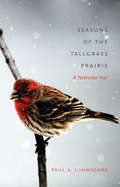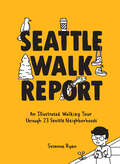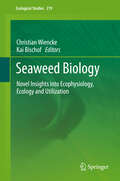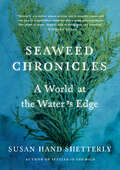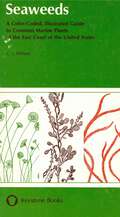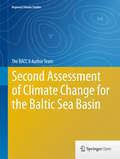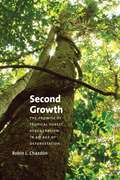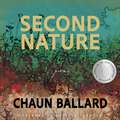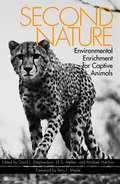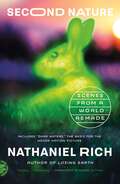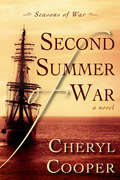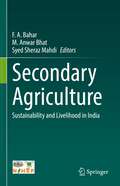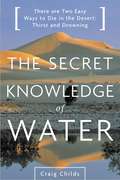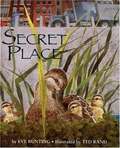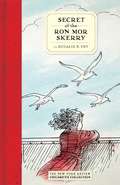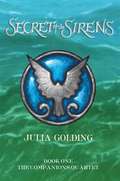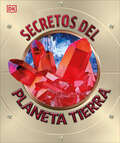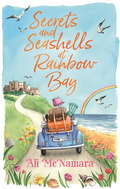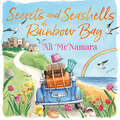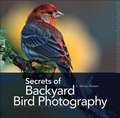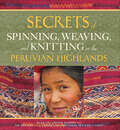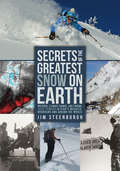- Table View
- List View
Seasons of the Tallgrass Prairie: A Nebraska Year
by Paul A. JohnsgardA respected author and scholar, Paul A. Johnsgard has spent a lifetime observing the natural delights of Nebraska’s woodlands, grasslands, and wetlands. Seasons of the Tallgrass Prairie collects his musings on Nebraska’s natural history and the issues of conservation facing our future. Johnsgard crafts essays featuring snow geese, owls, hummingbirds, and other creatures against the backdrop of Great Plains landscapes. He describes prairie chickens courting during predawn hours and the calls of sandhill cranes; he evokes the magic of lying upon the prairie, hearing only the sounds of insects and the wind through the grasses. From reflections following a visit to a Pawnee sacred site to meditations on the perils facing the state’s finite natural resources, Seasons of the Tallgrass Prairie celebrates the gifts of a half century spent roaming Nebraska’s back roads, trails, and sometimes-forgotten places.
Seattle Walk Report: An Illustrated Walking Tour through 23 Seattle Neighborhoods (Seattle Walk Report)
by Susanna Ryan Seattle Walk ReportInstagram sensation Seattle Walk Report uses her distinctive comic style and eagle eye to illustrate the charming and quirky people, places, and things that define Seattle's neighborhoods.Leveraging the growing popularity of Seattle Walk Report on Instagram, this charming book features comic book-style illustrations that celebrate the distinctive and odd people, places, and things that define Seattle's neighborhoods. The book goes deep into the urban jungle, exploring 24 popular Seattle neighborhoods, pulling out history, notable landmarks, and curiosities that make each area so distinctive. Entirely hand-drawn and lettered, Seattle Walk Report will be peppered with fun, slightly interactive elements throughout which make for an engaging armchair read, in addition to a fun way to explore the city's iconic, diverse, hipster, historic, and grand neighborhoods.
Seaweed Biology
by Kai Bischof Christian WienckeSeaweeds, also known as macroalgae, are among the most important primary producers and act as ecological engineers on rocky coasts of the world's oceans. In addition to their extreme ecological importance they are also of high economic relevance. Complementing available textbooks with its more research-oriented approach, this volume contains 22 chapters by renowned experts, grouped in five parts. In Part I fundamental processes and acclimation strategies of seaweeds towards the abiotic environment are covered. Part II focuses on the multitude of biotic interactions in seaweed communities, and in Part III the reader is introduced to the structure and function of the main seaweed systems of the world. The chapters of Part IV highlight and discuss the effects of global and local environmental changes on seaweeds and their communities. In the final Part V a comprehensive overview of developments in seaweed aquaculture, industrial applications and the overall economic importance of seaweeds is provided. Summarizing the advances in seaweed biology achieved within the last few decades, this book also identifies gaps in the present knowledge and needs for future research.
Seaweed Chronicles: A World at the Water's Edge
by Susan Hand Shetterly“You might not expect unfettered passion on the topic of seaweed, but Shetterly is such a great storyteller that you find yourself following along eagerly.” —Mark Kurlansky “Seaweed is ancient and basic, a testament to the tenacious beginnings of life on earth,” writes Susan Hand Shetterly in this elegant, fascinating book. “Why wouldn’t seaweeds be a protean life source for the lives that have evolved since?” On a planet facing environmental change and diminishing natural resources, seaweed is increasingly important as a source of food and as a fundamental part of our global ecosystem. In Seaweed Chronicles, Shetterly takes readers deep into the world of this essential organism by providing an immersive, often poetic look at life on the rugged shores of her beloved Gulf of Maine, where the growth and harvesting of seaweed is becoming a major industry. While examining the life cycle of seaweed and its place in the environment, she tells the stories of the men and women who farm and harvest it—and who are fighting to protect this critical species against forces both natural and man-made. Ideal for readers of such books as The Hidden Life of Trees and How to Read Water, Seaweed Chronicles is a deeply informative look at a little understood and too often unappreciated part of our habitat.
Seaweeds: A Color-Coded, Illustrated Guide to Common Marine Plants of the East Coast of the United States (G - Reference, Information and Interdisciplinary Subjects)
by C. J. HillsonAutomobiles, interstate highways, shorter work weeks, longer vacations, and higher salaries have all combined to bring the seashore closer to man. Where once a visit to the shore was only a dream for many, or a once-in-a-lifetime trip for others, the varied oceanic life that has held man's interest for centuries is now just beyond the garage doors of the American family. The same curiosity that stirs the beachcombing instincts of coastal dwellers is possessed by inlanders, and now a midwesterner too can do something about that curiosity. A vacation at the shore is much within his grasp as a visit to the nearest state park. Each year more and more inland residents are taking coastal vacations. As a result beachcombing is more popular than ever, with the same old questions being repeated over and over: "What's this?" "Where do you suppose they came from?" Is that a plant or an animal?" Unfortunately, the answers in too many instances are not readily available. This book is written for the layman. It is color-coded and fully illustrated. The casual visitor of the Atlantic Coast of the United States now has an easy to use, illustrated guide for the quick identification of the marine plants along the coast.
Second Assessment of Climate Change for the Baltic Sea Basin
by The BACC II Author TeamThis book is an update of the first BACC assessment, published in 2008. It offers new and updated scientific findings in regional climate research for the Baltic Sea basin. These include climate changes since the last glaciation (approx. 12,000 years ago), changes in the recent past (the last 200 years), climate projections up until 2100 using state-of-the-art regional climate models and an assessment of climate-change impacts on terrestrial, freshwater and marine ecosystems. There are dedicated new chapters on sea-level rise, coastal erosion and impacts on urban areas. A new set of chapters deals with possible causes of regional climate change along with the global effects of increased greenhouse gas concentrations, namely atmospheric aerosols and land-cover change. The evidence collected and presented in this book shows that the regional climate has already started to change and this is expected to continue. Projections of potential future climates show that the region will probably become considerably warmer and wetter in some parts, but dryer in others. Terrestrial and aquatic ecosystems have already shown adjustments to increased temperatures and are expected to undergo further changes in the near future. The BACC II Author Team consists of 141 scientists from 12 countries, covering various disciplines related to climate research and related impacts. BACC II is a project of the Baltic Earth research network and contributes to the World Climate Research Programme.
Second Growth: The Promise of Tropical Forest Regeneration in an Age of Deforestation
by Robin L. ChazdonFor decades, conservation and research initiatives in tropical forests have focused almost exclusively on old-growth forests because scientists believed that these "pristine” ecosystems housed superior levels of biodiversity. With Second Growth, Robin L. Chazdon reveals those assumptions to be largely false, bringing to the fore the previously overlooked counterpart to old-growth forest: second growth. Even as human activities result in extensive fragmentation and deforestation, tropical forests demonstrate a great capacity for natural and human-aided regeneration. Although these damaged landscapes can take centuries to regain the characteristics of old growth, Chazdon shows here that regenerating--or second-growth--forests are vital, dynamic reservoirs of biodiversity and environmental services. What is more, they always have been. With chapters on the roles these forests play in carbon and nutrient cycling, sustaining biodiversity, providing timber and non-timber products, and integrated agriculture, Second Growth not only offers a thorough and wide-ranging overview of successional and restoration pathways, but also underscores the need to conserve, and further study, regenerating tropical forests in an attempt to inspire a new age of local and global stewardship.
Second Nature
by Chaun BallardWinner of the 23rd annual Poulin Prize Chaun Ballard’s gripping debut collection weaves childhood experiences, historical events, and family stories into a living tapestry of memory that celebrates the landscape of Black America, both rural and urban. Riddled with the ghostly voices of family and friends, Second Nature is fearless in its wrestling with America’s fractured past and troubled present. In these poems, W.E.B. DuBois and Fredrick Douglass have a conversation, Michael Brown meditates on the nature of the cosmos, Johnnie Taylor’s guitar sings in sonnets, and the road Walt Whitman set out upon comes alive for a new generation. Through innovative re-imaginings of the sonnet, the pastoral, and the contrapuntal, Ballard engages with popular culture while examining the intricacies of all that is wedded together—form and content, mothers and fathers, grandmothers and grandfathers, husband and wife, and a nation long dependent on created binaries that serve to maintain structures of oppression. Interspersed with quotations and inspired by the rich legacy of poets who came before him—including poet Matthew Shenoda who provides an insightful Foreword to the collection—Second Nature is a testament to interconnectedness, a love letter to the deep roots that we come from, and a reminder of the myriad ways in which one’s identity is shaped by community and country.
Second Nature: Environmental Enrichment for Captive Animals
by Michael Hutchins Jill D. Mellen David J. ShepherdsonGrowing recognition of the complexity of animals' physical, social, and psychological lives in the wild has led both zookeepers and the zoo-going public to call for higher environmental standards for animals in captivity.Bringing together the work of animal behaviorists, zoo biologists, and psychologists, Second Nature explores a range of innovative strategies for environmental enrichment in laboratories and marine parks, as well as in zoos. From artificial fleeing-prey devices for leopards to irregular feeding schedules for whales, the practices discussed have resulted in healthier, more relaxed animals that can breed more easily and can exert some control over their environments. Moving beyond the usual studies of primates to consider the requirements of animals as diverse as reptiles, amphibians, marine mammals, small cats, hooved grazers, and bears, contributors argue that whether an animal forages in the wild or plays computer games in captivity, the satisfaction its activity provides--rather than the activity itself--determines the animal's level of physical and psychological well-being.Second Nature also discusses the ways in which environmental enrichment can help zoo-bred animals develop the stamina and adaptability for survival in the wild, and how it can produce healthier lab animals that yield more valid test results. Providing a theoretical framework for the science of environmental enrichment in a variety of settings, the book renews and extends a humane approach to the keeping and conservation of animals.From the Trade Paperback edition.
Second Nature: Scenes from a World Remade
by Nathaniel RichFrom the author of Losing Earth, a beautifully told exploration of our post-natural world that points the way to a new mode of ecological writing.We live at a time in which scientists race to reanimate extinct beasts, our most essential ecosystems require monumental engineering projects to survive, chicken breasts grow in test tubes, and multinational corporations conspire to poison the blood of every living creature. No rock, leaf, or cubic foot of air on Earth has escaped humanity's clumsy signature. The old distinctions—between natural and artificial, dystopia and utopia, science fiction and science fact—have blurred, losing all meaning. We inhabit an uncanny landscape of our own creation. In Second Nature, ordinary people make desperate efforts to preserve their humanity in a world that seems increasingly alien. Their stories—obsessive, intimate, and deeply reported—point the way to a new kind of environmental literature, in which dramatic narrative helps us to understand our place in a reality that resembles nothing human beings have known.From Odds Against Tomorrow to Losing Earth to the film Dark Waters (adapted from the first chapter of this book), Nathaniel Rich’s stories have come to define the way we think of contemporary ecological narrative. In Second Nature, he asks what it means to live in an era of terrible responsibility. The question is no longer, How do we return to the world that we’ve lost?It is, What world do we want to create in its place?
Second Site (POINT: Essays on Architecture #4)
by James NisbetA meditation on how environmental change and the passage of time transform the meaning of site-specific artIn the decades after World War II, artists and designers of the land art movement used the natural landscape to create monumental site-specific artworks. Second Site offers a powerful meditation on how environmental change and the passage of time alter and transform the meanings—and sometimes appearances—of works created to inhabit a specific place.James Nisbet offers fresh approaches to well-known artworks by Ant Farm, Rebecca Belmore, Nancy Holt, Richard Serra, and Robert Smithson. He also examines the work of less recognized artists such as Agnes Denes, Bonnie Devine, and herman de vries. Nisbet tracks the vicissitudes wrought by climate change and urban development on site-specific artworks, taking readers from the plains of Amarillo, Texas, to a field of volcanic rock in Mexico City, to abandoned quarries in Finland.Providing vital perspectives on what it means to endure in an ecologically volatile world, Second Site challenges long-held beliefs about the permanency of site-based art, with implications for the understanding and conservation of artistic creation and cultural heritage.
Second Summer of War
by Cheryl CooperA dramatic, heart-warming a tale of life on the sea. Set in 1813, Second Summer of War is a sequel to Come Looking for Me. With the British traitor Captain Thomas Trevelyan incarcerated on a prison hulk in Portsmouth Harbour, Princess Emeline "Emily" Louisa sails back to England and is summarily dispatched to Hartwood Hall, home of the disagreeable Duke and Duchess of Belmont. There she endures weeks awaiting Trevelyan’s trial, unable to leave the estate or find useful occupation. Relations with her guardians, chilly at best, soon escalate into a battle of wills when they attempt to marry her off in order to secure favour with her uncle, the Prince Regent. Meanwhile, England’s naval war with the United States continues to rage on the Atlantic. When Fly Austen and his friend, Dr. Leander Braden, are given Admiralty Orders to testify at the trial, they return home with the hope of seeing Emily one last time. Their journey is anything but uneventful as they encounter devastating storms, menacing ships, and a spectre that proclaims their impending doom.
Secondary Agriculture: Sustainability and Livelihood in India
by Syed Sheraz Mahdi F. A. Bahar M. Anwar BhatThis book on ‘Secondary Agriculture’ discusses the goal of doubling farmers’ incomes. The term ‘secondary’ has a bearing on climate change adaptation and its mitigation, small farm viability and profitability, food security, nutrition, sustainable utilization of natural resources, and optimal usage of produce from primary agriculture and farm incomes. Promoting secondary agriculture has implications on attaining sustainable development goals, which aim to connect primary, secondary and tertiary sectors by using slack/idle factors of production, such as land and labour, contributing to primary agriculture production, capturing ‘value’ in primary agricultural activities, and generating additional income at the enterprise level. In context to same, the chapters of this book have been designed to promote secondary agriculture through low-cost skills and technology applications in agriculture and by upscaling knowledge via integrating primary, secondary and tertiary sectors of agriculture. The motivation behind this book is to address the challenges of biotic and abiotic stresses facing the farming community; to increase farmers income through low-cost skills and technology applications in agriculture; to upscale knowledge by integrating primary, secondary and tertiary sectors of agriculture. The food processing sector in India is still in a nascent stage with only 8 per cent of the produce being processed as against 80-98 per cent in case of high-income countries (Government of India, 2008, 2010). The food processing sector is now receiving the boost with the annual growth of 13.2 per cent in registered food processing units during 2004-10 (Government of India, 2011). Against this backdrop, there is a strong need to strategically handle the situation in order to facilitate a self-sustainable and long-run growth of the sector, which is felt possible by focusing on Secondary Agriculture. Though not a panacea for all ailments of the primary sector, but it can definitely drive the growth.
Secret Garden
by Cathryn ParryHidden from the world... A reclusive artist in the Scottish Highlands, Rhiannon MacDowall is an enigma. Few people know about her carefully structured life, or why she hides within the protection of her family's estate. Until an errant golf ball changes everything... Colin Walker was once Rhiannon's best friend. Now he's a pro golfer on the verge of ruin who's returned to Scotland on family business. But as much as Rhiannon tries to keep Colin out, their connection remains-and turns into something both exhilarating and terrifying. Something that threatens the foundations of Rhiannon's safe little world.
Secret Knowledge of Water: There Are Two Easy Ways to Die in the Desert: Thirst and Drowning
by Craig ChildsDeserts are environments that can be inhospitable even to seasoned explorers. Craig Childs has spent years in the deserts of the American West, and his treks through arid lands in search of water reveal the natural world at its most extreme.
Secret of the Ron Mor Skerry
by Rosalie K. FryFiona McConville is a child of the Western Isles, living on the Scottish mainland. City life doesn’t suit Fiona and at age ten she is sent back to her beloved isles to live with her grandparents. There she learns more about her mother’s strange ways with the seals and seabirds; hears stories of the selkies, mythological creatures that are half seal and half human; and wonders about her baby brother, Jamie, who disappeared long ago but whom fishermen claim to have seen. Fiona is determined to find Jamie and enlists her cousin Rory to help. When her grandparents are suddenly threatened with eviction, Fiona and Rory go into action. Secret of the Ron Mor Skerry is a magical story of the power of place and family history, interwoven with Scottish folklore. Rosalie K. Fry’s novel, which was the basis for John Sayles’s classic 1994 film The Secret of Roan Inish, is back in print for the first time in decades.
Secret of the Sirens (Companions Quartet #1)
by Julia GoldingUpon moving to her aunt's seaside home in the British Isles, Connie becomes part of a secret society that shelters mythical creatures, and must use her ability to communicate with these beings to protect them from evil and the incursions of humans.
Secretos del Planeta Tierra (Explanatorium of the Earth)
by DKUna completísima enciclopedia juvenil para explorar nuestro planeta de forma diferente.Emprende un increíble viaje al corazón de nuestro planeta y descubre cómo las placas tectónicasse separan y chocan, observa la erosión que sufre la Tierra a lo largo del tiempo, explora el interior de un volcán, aprende sobre el cambio climático y el calentamiento global y mucho más.¿Cuántos volcanes activos existen? ¿Qué provoca los tornados y los huracanes? ¿Cómo se forman las rocas, los fósiles y las gemas? ¿De qué se compone el aire?Con cantidad de datos curiosos e increíbles fotografías e imágenes de todo tipo de fenómenos, este libro ilustrado para niños responde a todas las preguntas sobre nuestro universo, ya se trate del origen de la vida en la Tierra, la atmósfera, los fósiles, los océanos o la actividad tectónica.Incluye datos asombrosos sobre geología, accidentes geográficos y paisajes, fósiles, rocas y minerales, climatología, el sistema solar y mucho más.Con explicaciones sencillas de más de 100 principios científicos: la materia, las reacciones, los materiales, las fuerzas, la energía, la vida y la Tierra.Impresionantes fotografías de primeros planos, además de increíbles imágenes macro, cortes transversales e imágenes tomadas con time-lapse, rayos X y ultravioleta.Un libro de consulta esencial en las bibliotecas familiares y el complemento perfecto para los trabajos escolares.Perfecto para niños a partir de 9 años interesados en las ciencias de la Tierra y los fenómenos naturales y meteorológicos.Un regalo especial que los niños guardarán como un tesoro.---------------------------------- Welcome to the Explanatorium of the Earth - the only Earth encyclopedia you'll ever need, with excellent photographs of everything from supervolcanoes to tsunamis. This Earth exploration book for kids aged 9-12 and beyond answers the biggest and smallest questions about our universe, whether it’s fossils, oceans, or geology. The Exploratorium of Earth brings science to life with striking photographic explanations, helping kids understand how the world works.This fact-filled encyclopedia for kids offers:An extensive earth science guide– explaining more than 100 scientific principles, including matter, reactions, materials, forces, energy, life, and Earth.Detailed, close-up photography, plus incredible macro images, cross-sections, exploded views, time-lapse, x-ray, and ultra-violet photography.What makes volcanoes erupt? Why are tornadoes and hurricanes so destructive? How do rocks, fossils, and gems form? Explanatorium of the Earth takes you on an incredible voyage deep into the heart of our planet and back to discover the powerful forces that continually shape and remodel our ever-changing world. Discover how tectonic plates tear apart and cause earthquakes. Learn how the slow but relentless process of erosion and weathering wears away rock, reducing mountains to dust and carving valleys and canyons into the land. And learn how the living world and rock cycles have worked together for millions of years to stabilize the planet's climate, keeping Earth suitable for life.Are you interested in other subjects? Explore more from the Explanatorium series, such as Explanatorium of History, Explanatorium of Nature, and Explanatorium of Science.
Secrets and Seashells at Rainbow Bay
by Ali McNamaraThe sun is shining on the golden castle on Rainbow Bay - and change is in the air!Amelia is a single mother, doing her very best to look after her young son, Charlie - but money is tight and times are tough. When she first hears that she is the last descendent of the Chesterford family and that she has inherited a Real-Life Castle by the sea, Amelia can't quite believe her ears. But it's true!She soon finds that owning a castle isn't quite the ticket to sorting out her money problems that she'd first hoped: she can't sell, because the terms of the ancient bequest state that any Chesterford who inherits the castle, must live there and work towards the upkeep and maintenance of the family home. So ever-practical Amelia decides to uproot her little family and move to this magnificent castle by the sea. Living in a castle on the beautiful Northumberland coast is fun at first, but organising the day-to-day running is a lot more complicated than Amelia first imagined. Luckily she has help from the small band of eccentric and unconventional staff that are already employed there - and a mysterious unseen hand that often gives her a push in the right direction just when she needs it most. It's only when she meets Tom, a furniture restorer who comes to the castle to help repair some antique furniture, that Amelia realises she might get the fairy-tale ending that she and Charlie truly deserve...Join bestselling author Ali McNamara in Rainbow Bay, where an inheritance and some sea air are about to work their magic on Amelia's life...
Secrets and Seashells at Rainbow Bay
by Ali McNamaraThe sun is shining on the golden castle on Rainbow Bay - and change is in the air!Amelia is a single mother, doing her very best to look after her young son, Charlie - but money is tight and times are tough. When she first hears that she is the last descendent of the Chesterford family and that she has inherited a Real-Life Castle by the sea, Amelia can't quite believe her ears. But it's true!She soon finds that owning a castle isn't quite the ticket to sorting out her money problems that she'd first hoped: she can't sell, because the terms of the ancient bequest state that any Chesterford who inherits the castle, must live there and work towards the upkeep and maintenance of the family home. So ever-practical Amelia decides to uproot her little family and move to this magnificent castle by the sea. Living in a castle on the beautiful Northumberland coast is fun at first, but organising the day-to-day running is a lot more complicated than Amelia first imagined. Luckily she has help from the small band of eccentric and unconventional staff that are already employed there - and a mysterious unseen hand that often gives her a push in the right direction just when she needs it most. It's only when she meets Tom, a furniture restorer who comes to the castle to help repair some antique furniture, that Amelia realises she might get the fairy-tale ending that she and Charlie truly deserve...Join bestselling author Ali McNamara in Rainbow Bay, where an inheritance and some sea air are about to work their magic on Amelia's life...
Secrets and Seashells at Rainbow Bay
by Ali McNamaraThe sun is shining on the golden castle on Rainbow Bay - and change is in the air!Amelia is a single mother, doing her very best to look after her young son, Charlie - but money is tight and times are tough. When she first hears that she is the last descendent of the Chesterford family and that she has inherited a Real-Life Castle by the sea, Amelia can't quite believe her ears. But it's true!She soon finds that owning a castle isn't quite the ticket to sorting out her money problems that she'd first hoped: she can't sell, because the terms of the ancient bequest state that any Chesterford who inherits the castle, must live there and work towards the upkeep and maintenance of the family home. So ever-practical Amelia decides to uproot her little family and move to this magnificent castle by the sea. Living in a castle on the beautiful Northumberland coast is fun at first, but organising the day-to-day running is a lot more complicated than Amelia first imagined. Luckily she has help from the small band of eccentric and unconventional staff that are already employed there - and a mysterious unseen hand that often gives her a push in the right direction just when she needs it most. It's only when she meets Tom, a furniture restorer who comes to the castle to help repair some antique furniture, that Amelia realises she might get the fairy-tale ending that she and Charlie truly deserve...Join bestselling author Ali McNamara in Rainbow Bay, where an inheritance and some sea air are about to work their magic on Amelia's life...
Secrets of Backyard Bird Photography
by J. Chris HansenPhotographing birds in your backyard is a convenient, rewarding, and addictive adventure. Secrets of Backyard Bird Photography is a guide to that pursuit. In this book, author and wildlife photographer J. Chris Hansen teaches techniques for creating professional-quality images of the subjects right in your yard. This book covers all aspects of backyard bird photography, including the best camera equipment to use and the basics of attracting birds using bird feeders, perches, backgrounds, and photo blinds. You'll learn about the common camera settings and composition styles used to create outstanding backyard bird images. This book also offers ideas and examples of ways to exhibit your photography, including step-by-step instructions for a variety of fun, easy projects for the do-it-yourselfer. Secrets of Backyard Bird Photography contains a collection of beautiful, detailed images that illustrate the important aspects of creating stunning photographs of the birds right in your backyard.
Secrets of Spinning, Weaving, and Knitting in the Peruvian Highlands
by Nilda Callañaupa AlvarezWinner, Silver Medal in the Craft/Hobby Category, 2018 IBPA Benjamin Franklin Awards Nilda Callañaupa Alvarez has gathered artisans of all ages to share their knowledge, lore, and deep skills, highlighting many of the techniques used by craftspeople in the Andes. They reveal clever highland secrets for everything from skeining yarn and knitting in reverse to weaving tubular borders and embellishing fabric with complex stitches. For many of these techniques, they provide concise step-by-step instructions accessible for North American crafters. Thoughtful, detailed descriptions of Andean cultural traditions frame each section, providing context and rare insight into what textile work means as a living heritage of the Quechua people.
Secrets of the Greatest Snow on Earth: Weather, Climate Change, and Finding Deep Powder in Utah's Wasatch Mountains and around the World
by Jim SteenburghUtah has long claimed to have the greatest snow on Earth—the state itself has even trademarked the phrase. In Secrets of the Greatest Snow on Earth, Jim Steenburgh investigates Wasatch weather, exposing the myths, explaining the reality, and revealing how and why Utah’s powder lives up to its reputation. Steenburgh also examines ski and snowboard regions beyond Utah, making this book a meteorological guide to mountain weather and snow climates around the world. Chapters explore mountain weather, avalanches and snow safety, historical accounts of weather events and snow conditions, and the basics of climate and weather forecasting. Steenburgh explains what creates the best snow for skiing and snowboarding in accurate and accessible language and illustrates his points with 150 color photographs, making Secrets of the Greatest Snow on Earth a helpful tool for planning vacations and staying safe during mountain adventures. Snowriders, weather enthusiasts, meteorologists, students of snow science, and anyone who dreams of deep powder and bluebird skies will want to get their gloves on Secrets of the Greatest Snow on Earth. Watch Book Trailer!(Special thanks to Ski Utah)
